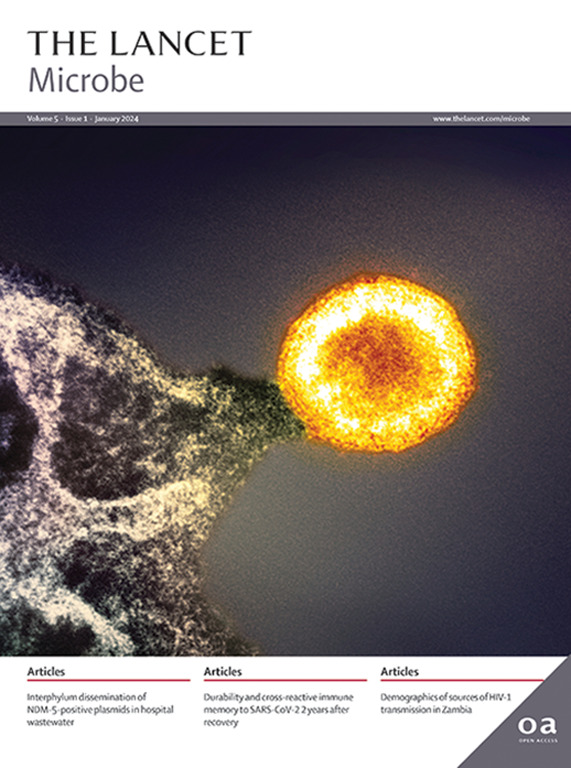1994年至2022年荷兰耐三唑烟曲霉:基因组和表型研究
IF 20.4
1区 生物学
Q1 INFECTIOUS DISEASES
引用次数: 0
摘要
背景:烟曲霉是侵袭性曲霉病的主要病因,三唑类抗真菌药物是主要的治疗选择。耐药的出现阻碍了三唑治疗的有效性,主要是由cyp51A基因突变和启动子区域34个碱基(TR34/Leu98His)和46个碱基(TR46/Tyr121Phe/Thr289Ala)的串联重复序列(TR)引起的,这与三唑抗性表型相对应。我们旨在调查荷兰29年来三唑表型和基因型变异的发生情况。方法:在这项基因组和表型研究中,我们使用基于琼脂的方法筛选了1994年1月6日至2022年12月31日期间从荷兰医院收集的所有临床烟曲霉分离株对三唑的耐药性,并通过cyp51A基因测序和体外药敏试验对其进行了鉴定,采用欧洲抗微生物药物敏感性试验委员会参考方法。对选定的分离株进行全基因组测序,包括那些携带TR34变异、高频单核苷酸多态性和野生型菌株的分离株。收集了2017年1月1日至2022年12月31日期间在荷兰奈梅亨内梅亨大学医学中心培养的分离株患者的年龄、基础疾病、诊断、治疗和结果等临床信息。结果:在12 679株烟曲霉A中,1979株(15.6%)存在cyp51A三唑耐药突变,其中1338株(67.6%)耐药菌株中TR34/Leu98His为主,332株(16.8%)耐药菌株中TR46/Tyr121Phe/Thr289Ala为主。325株(17.2%)具有耐药机制的三唑耐药菌株出现表型和基因型变异,其中12株为cyp51A基因型变异。全基因组测序结果显示,具有tr34和tr46多态性组合的分离株似乎来自不同的种群,但存在一定的重叠。确定了59例确诊或可能的侵袭性曲霉病,包括13例三唑耐药病例,其中3例由基因型变异引起。13例三唑耐药患者中有11例(84.6%)出现混合基因型感染,且与三唑敏感疾病相比,抗真菌治疗切换的数量更高。(解释:我们的研究显示,临床具有cyp51a介导耐药的烟曲霉分离株三唑基因型和表型存在差异,其中一些菌株来自三唑耐药侵袭性曲霉病病例。三唑耐药变异和混合烟曲霉基因型是曲霉疾病临床管理的主要挑战,因为目前的分子诊断工具将越来越无法预测耐药表型,这强调了改进检测方法的必要性。基金资助:国家重点研发计划、国家自然科学基金、惠康信托基金。本文章由计算机程序翻译,如有差异,请以英文原文为准。
Triazole-resistant Aspergillus fumigatus in the Netherlands between 1994 and 2022: a genomic and phenotypic study
Background
Aspergillus fumigatus is the main cause of invasive aspergillosis and triazole antifungals are the primary treatment option. The effectiveness of triazole therapy is hampered by the emergence of resistance, mainly caused by mutations in the cyp51A gene and a tandem repeat (TR) of 34 bases (TR34/Leu98His) and 46 bases (TR46/Tyr121Phe/Thr289Ala) in the promoter region, which correspond with signature triazole resistance phenotypes. We aimed to investigate the occurrence of triazole phenotype and genotype variation over a 29-year period in the Netherlands.
Methods
In this genomic and phenotypic study, we screened all clinical A fumigatus isolates from Dutch hospitals collected between Jan 6, 1994, and Dec 31, 2022, for resistance to triazole using agar-based methods, and characterised them by sequencing the cyp51A gene and in vitro susceptibility testing using the European Committee on Antimicrobial Susceptibility Testing reference method. Whole-genome sequencing was performed on selected isolates, including those harboring TR34 variants, high-frequency single-nucleotide polymorphisms, and wild-type strains. Clinical information such as age, underlying disease, diagnosis, therapy, and outcomes was collected for patients who had isolates cultured at the Radboud University Medical Centre, Nijmegen, Netherlands, between Jan 1, 2017, and Dec 31, 2022.
Findings
1979 (15·6%) of the screened 12 679 A fumigatus isolates harboured cyp51A triazole resistance mutations, predominately TR34/Leu98His sensu stricto in 1338 (67·6%) resistant isolates and TR46/Tyr121Phe/Thr289Ala sensu stricto in 332 (16·8%) resistant isolates. Phenotype and genotype variations were observed in 325 (17·2%) triazole resistant isolates harbouring a TR-resistance mechanism, including 12 cyp51A genotype variants. Whole-genome sequencing showed that isolates with combinations of TR34-based and TR46-based polymorphisms seemed to be derived from separate populations, but there was some overlap. 59 cases of proven or probable invasive aspergillosis were identified, including 13 triazole-resistant cases, of which three were caused by genotype variants. Mixed genotype infection was observed in 11 (84·6%) of 13 triazole-resistant patients and the number of antifungal treatment switches was higher compared with triazole-susceptible disease (p<0·0001).
Interpretation
Our study showed variation in triazole genotypes and phenotypes in clinical A fumigatus isolates with cyp51A-mediated resistance, some of which were cultured from triazole-resistant invasive aspergillosis cases. Triazole resistance variation and mixed A fumigatus genotypes represent a major challenge in clinical management of Aspergillus diseases because current molecular diagnostic tools will increasingly fail to predict the resistance phenotype, underscoring the need for improved detection methods.
Funding
National Key Research and Development Program of China, National Natural Science Foundation of China, and Wellcome Trust.
求助全文
通过发布文献求助,成功后即可免费获取论文全文。
去求助
来源期刊

Lancet Microbe
Multiple-
CiteScore
27.20
自引率
0.80%
发文量
278
审稿时长
6 weeks
期刊介绍:
The Lancet Microbe is a gold open access journal committed to publishing content relevant to clinical microbiologists worldwide, with a focus on studies that advance clinical understanding, challenge the status quo, and advocate change in health policy.
 求助内容:
求助内容: 应助结果提醒方式:
应助结果提醒方式:


